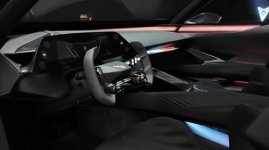What we know
These are the confirmed or strongly reported facts about the Tindaya concept.
Exterior / Design
- It’s Cupra’s biggest model so far: ~4.72 metres long (185.8 in)
- Bold, aggressive styling: sharp lines, muscular haunches, sculpted side profile. Lots of detail.
- Massive 23-inch wheels.
- “Black Mask“ front fascia with a digital screen strip that can animate / mimic breathing — part of the design drama.
- Fast-back roofline / shooting brake-ish crossover silhouette. A roof-spine (3D printed aluminum) runs across, with detachable panels.
- Exterior finishes use “colour-shifting matte paint” or gradient finishes (from dark grey to cuprous / warm tones) reflecting Atlantic sea / volcanic terrain inspiration.
Interior / Driver Focus & Materials
- Layout is 2+2: two front bucket seats + two smaller rear seats.
- Bucket seats with racing inspiration, “floating” seat feel, etc. Emphasis on sporty, immersive driving experience.
- Steering yoke instead of traditional wheel. Somewhat gaming/racing inspired controls.
- A large 24-inch display ahead of the driver. Also a display running along the base of the windscreen, ambient lighting integrated.
- Minimal touchscreens: physical buttons / switches for many controls. Cupra seems to want more tactile interaction.
- Sustainable / innovative materials: bio-based leather, natural fibres, ultrasuede, etc. Some 3D-printed aluminium.
- A “Jewel” in the centre console — a prism-like, tactile / sensory device used to change drive modes, lighting / ambience / driver experience.

Powertrain / Performance / Range & Tech
- Dual electric motors (one on each axle) giving ≈ 489 bhp (or ~horsepower equivalent) in the range-extender (REx/REEV) version.
- Pure-electric mode can drive about 186 miles (≈ 300 km) on battery alone.
- With a range extender (1.5-litre four-cylinder petrol engine) acting as generator to charge battery / maintain range, the total possible driving range climbs to ≈ 620-621 miles (≈ 1,000 km).
- Acceleration: 0-62 mph (0-100 km/h approx) in 4.1 seconds in the range-extender version.
Strategy & Positioning
- The concept uses (or previews) Volkswagen Group’s SSP (Scalable Systems Platform).
- Cupra emphasizes driver experience / emotion: “No drivers, no Cupra” slogan repeatedly used. They are resisting trends toward full autonomy; driver remain central.
- Some design and tech elements are expected to make it into future production Cupra models, albeit toned down. But concept nature means many details are aspirational.
What isn't resolved / What remains speculative
- Whether the long-range (≈ 1,000 km) range-extender version will make it to production in anything close to this form. Concept cars often have optimistic claims.
- Exact battery capacity / charging times are not confirmed. We know battery-only range (~300 km) but not kWh figure or charge speed.
- Some of the more radical design features (yoke, reverse-opening doors, floating seats, full width displays, etc.) may be too expensive or impractical for mass production. They may be simplified.
- Timeline: One report suggests it might arrive around 2030 in production form.
- Cost, local versions, trim levels, safety / regulatory compliance are all unknown yet.
My take / Assessment
Putting this together, the Tindaya concept is very exciting — a bold statement from Cupra about where they want to go in design, range, driver engagement. But like many concepts, it’s as much about signalling brand direction as it is a product you can buy tomorrow.
If they pull off a production version with even 80-90% of the claimed range, good power, with more “real world” practicality, it could be a serious contender in the premium EV / hybrid-EV space. The range extender version is interesting because many people worry about limited pure EV range, and the REx model offers a compromise. But it also adds complexity, weight, potential costs, emissions concerns.
